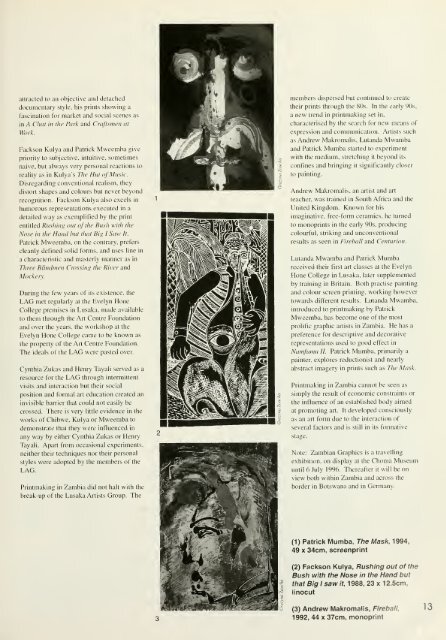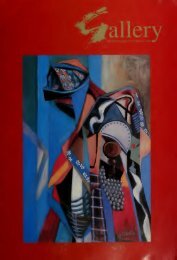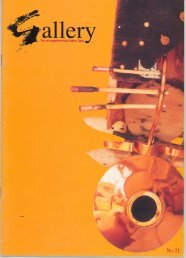Gallery : the art magazine from Gallery Delta
Gallery : the art magazine from Gallery Delta
Gallery : the art magazine from Gallery Delta
You also want an ePaper? Increase the reach of your titles
YUMPU automatically turns print PDFs into web optimized ePapers that Google loves.
attracted to an objective and detached<br />
documentary style, his prints showing a<br />
fascination for market and social scenes as<br />
in A Chcit in <strong>the</strong> Park and Craftsmen al<br />
Work.<br />
Fackson Kulya and Patrick Mweemba give<br />
priority to subjective, intuitive, sometimes<br />
naive, but always very personal reactions to<br />
reality as in Kulya's The Hitl of Music.<br />
Disregarding conventional realism, <strong>the</strong>y<br />
distort shapes and colours but never beyond<br />
recognition. Fackson Kulya also excels in<br />
humorous representations executed in a<br />
detailed way as exemplified by <strong>the</strong> print<br />
entitled Rushing out of <strong>the</strong> Bush with <strong>the</strong><br />
Nose in <strong>the</strong> Hand hut that Big I Saw It.<br />
Patrick Mweemba. on <strong>the</strong> contrary, prefers<br />
cleanly defined solid forms, and uses line in<br />
a characteristic and masterly manner as in<br />
Three Blindmen Crossing <strong>the</strong> River and<br />
Mockery.<br />
During <strong>the</strong> few years of its existence, <strong>the</strong><br />
LAG met regularly at <strong>the</strong> Evelyn Hone<br />
College premises in Lusaka, made available<br />
to <strong>the</strong>m through <strong>the</strong> Art Centre Foundation<br />
and over <strong>the</strong> years, <strong>the</strong> workshop at <strong>the</strong><br />
Evelyn Hone College came to be known as<br />
<strong>the</strong> property of <strong>the</strong> Art Centre Foundation.<br />
The ideals of <strong>the</strong> LAG were pasted over.<br />
Cynthia Zukas and Henry Tayali served as a<br />
resource for <strong>the</strong> LAG through intermittent<br />
visits and interaction but <strong>the</strong>ir social<br />
position and formal <strong>art</strong> education created an<br />
invisible barrier that could not easily be<br />
crossed. There is very little evidence in <strong>the</strong><br />
works of Chibwe. Kulya or Mweemba to<br />
demonstrate that <strong>the</strong>y were influenced in<br />
any way by ei<strong>the</strong>r Cynthia Zukas or Henry<br />
Tayali. Ap<strong>art</strong> <strong>from</strong> occasional experiments,<br />
nei<strong>the</strong>r <strong>the</strong>ir techniques nor <strong>the</strong>ir personal<br />
styles were adopted by <strong>the</strong> members of <strong>the</strong><br />
LAG.<br />
Printmaking in Zambia did not halt with <strong>the</strong><br />
break-up of <strong>the</strong> Lusaka Artists Group. The<br />
members dispersed but continued to create<br />
<strong>the</strong>ir prints through <strong>the</strong> 80s. In <strong>the</strong> early 90s,<br />
a new trend in printmaking set in,<br />
characterised by <strong>the</strong> search for new means of<br />
expression and communication. Artists such<br />
as Andrew Makromalis, Lutanda Mwamba<br />
and Patrick Mumba st<strong>art</strong>ed to experiment<br />
with <strong>the</strong> medium, stretching it beyond its<br />
confines and bringing it significantly closer<br />
to painting.<br />
Andrew Makromalis. an <strong>art</strong>ist and <strong>art</strong><br />
teacher, was trained in .South Africa and <strong>the</strong><br />
United Kingdom. Known for his<br />
imaginative, free-form ceramics, he turned<br />
to monoprints in <strong>the</strong> early 90s. producing<br />
colourful, striking and unconventional<br />
results as seen in Fireball and Centurion.<br />
Lutanda Mwamba and Patrick Mumba<br />
received <strong>the</strong>ir first <strong>art</strong> classes at <strong>the</strong> Evelyn<br />
Hone College in Lusaka, later supplemented<br />
by training in Britain. Both practise painting<br />
and colour screen printing, working however<br />
towards different results. Lutanda Mwamba.<br />
introduced to printmaking by Patrick<br />
Mweemba, has become one of <strong>the</strong> most<br />
prolific graphic <strong>art</strong>ists in Zambia. He has a<br />
preference for descriptive and decorative<br />
representations used to good effect in<br />
Namfunui II. Patrick Mumba, primarily a<br />
painter, explores reductionist and nearly<br />
abstract imagery in prints such as The Mask.<br />
Printmaking in Zambia cannot be seen as<br />
simply <strong>the</strong> result of economic constraints or<br />
<strong>the</strong> influence of an established body aimed<br />
at promoting <strong>art</strong>. It developed consciously<br />
as an <strong>art</strong> form due to <strong>the</strong> interaction of<br />
several factors and is still in its formative<br />
stage.<br />
Note: Zambian Graphics is a travelling<br />
exhibition, on display at <strong>the</strong> Chonia Museum<br />
until 6 July 1996. Thereafter it will be on<br />
view both within Zambia and across <strong>the</strong><br />
border in Botswana and in Germany.<br />
(1) Patrick Mumba, The Mask, 1994,<br />
49 X 34cm, screenprint<br />
(2) Fackson Kulya, Rushing out of <strong>the</strong><br />
Bush with <strong>the</strong> Nose in <strong>the</strong> Hand but<br />
that Big I saw it, 1988, 23 x 12.5cm,<br />
linocut<br />
(3) Andrew Makromalis, Fireball,<br />
1992, 44 X 37cm, monoprint<br />
1







